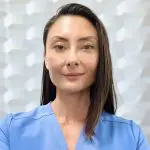Ear Piercing
While you may not think of seeing a board-certified dermatologist to have your ears pierced, Dr. Jochen feels strongly that by providing this service, he is helping to ensure patients’ safety, performing the procedure in a more sterile environment than retail operations can offer and reducing the risk of infection.
Earlobe Repair
It can happen in an instant. A once beautifully-pierced ear becomes an unsightly torn ear lobe. An ear ring tangle with hair or fingernail, a child’s grabbing hands, or some other injury can damage the tender ear lobe tissue which is comprised of skin and fat. The wear and weight of loop and dangling earrings over time can make the hole larger. Sometimes it takes only the smallest tug to tear the lobe.
Dr. Timothy Jochen expertly performs ear lobe reconstruction and says that once repaired and sufficiently healed, patients can pierce their ears again if they so desire. Sometimes the ear can be reconstructed with an earring stud in place to retain the piercing.
The simple outpatient procedure takes about 15 minutes and is performed with a local anesthetic to numb the ear lobe. The sutures will dissolve in a few days. Depending on the extent of the injury, immediate repair may be an option or the patient may need to let the wound heal before surgery is recommended. Even in the case of lost tissue, the ear lobe can be reshaped to look proportional.
To prevent the possibility of a tear, always remove earrings before taking sweaters and shirts off, and take earrings off when around young children.
Nasolabial Fold Correction
The nasolabial folds are the deep folds which run from the side of the nose to the corner of the mouth. As we age, they often become more noticeable, although younger people with fatty cheek pads may also have prominent nasolabial folds.
While dermal fillers have become a popular and effective way to “plump up” nasolabial folds in patients with moderately prominent folds, a procedure called nasolabial fold excision is another option, particularly for severe nasolabial folds in mature patients with thicker skin.
Nasolabial fold excision is performed under local anesthesia along with oral or intravenous sedatives to relax you. Dr. Jochen will excise (surgically remove) the nasolabial folds from the face and suture the treated areas with tiny hairline stitches.
You will be instructed to keep your treatment area as immobile as possible for a week to 10 days to encourage proper healing. If your body tends to form keloids (thick, irregular scarring caused by excessive tissue growth at the site of an incision or wound), this procedure may not be appropriate for you.
















